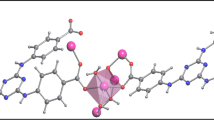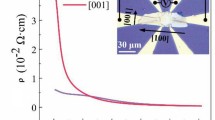Abstract
The titled material crystallizes with an orthorhombic unit cell, in the P21212 space group (Nr. 18). Its crystal structure was solved and refined from powder XRD patterns. The solid framework is formed by stacked undulated sheets of inorganic nature, Fe[Fe(CN)5NO], separated by bimolecular organic pillars, [4-(3-Phenylpropyl)pyridine]2, which remain coordinated to the axial coordination sites for the iron atom. The molecules forming these pillars remain coupled through C–H⋯π and dispersive interactions between neighboring molecules. When this solid is cooled and then warmed, a reversible spin transition, from high to low spin (HS → LS), and vice versa, is observed. This transition occurs in the temperature interval of 135–165 K, with a hysteresis between them of about 30 K. That hysteresis loop appears with a pronounced asymmetry when the slopes for the HS → LS and LS → HS transitions are compared. This effect is discussed in terms of the related structural changes in the solid structure during the spin transitions. The transition was also monitored from IR and Raman spectra recorded at 80 and 300 K. Relevant information on the electronic structure for both, the LS and HS phases of this material, was derived from the corresponding XPS spectra recorded at 114 and 270 K. This contribution emphasizes the role of the nitrosyl group (NO) as an electron buffer for tuning the bonding properties of the inorganic layer at the CN 5σ orbital to make possible the observed thermally-induced SCO behavior.
Graphical Abstract
The thermally-induced spin transition in this solid shows an asymmetric hysteresis loop, which was ascribed to the nature of the pillar molecule.









Similar content being viewed by others
References
L. Reguera, Y. Avila, E. Reguera, Transition metal nitroprussides: crystal and electronic structure, and related properties. Coord. Chem. Rev. 434, 213764 (2021). https://doi.org/10.1016/j.ccr.2020.213764
E. König, G. Ritter, S.K. Kulshreshtha, The nature of the spin-state transitions in solid complexes of iron(II) and the interpretation of some associated phenomena. Chem. Rev. 85, 219–234 (1985). https://doi.org/10.1021/cr00067a003
E. König, Structural changes accompanying continuous and discontinuous spin-state transitions. Prog. Inorg. Chem. 35, 527–622 (1987)
O. Kahn, J. Kröber, C. Jay, Spin transition molecular materials for displays and data recording. Adv. Mater. 4, 718–728 (1992). https://doi.org/10.1002/adma.19920041103
P. Gütlich, Y. Garcia, H. Spiering, Spin Transition Phenomena, in Magnetism: Molecules to Materials IV (Wiley, Weinheim, 2003), pp. 271–344
M.A. Halcrown, Spin-Crossover Materials: Properties and Applications, 1st edn. (Wiley, New York, 2013)
P. Gütlich, A.B. Gaspar, Y. Garcia, Spin state switching in iron coordination compounds. Beilstein J. Org. Chem. 9, 342–391 (2013). https://doi.org/10.3762/bjoc.9.39
O. Kahn, C.J. Martínez, Spin-transition polymers: from molecular materials toward memory devices. Science 279, 44–48 (1998). https://doi.org/10.1126/science.279.5347.44
S. Vela, M. Fumanal, J. Cirera, J. Ribas-Arino, Thermal spin crossover in Fe(II) and Fe(III). Accurate spin state energetics at the solid state. Phys. Chem. Chem. Phys. 22, 4938–4945 (2020)
S. Vela, M. Fumanal, J. Ribas-Arino, V. Robert, Towards accurate and computationally-efficient modelling of Fe(II)-based spin-crossover materials. Phys. Chem. Chem. Phys. 17, 16306–16314 (2015). https://doi.org/10.1039/C5CP02502H
M.D. Manrique-Juarez, S. Rat, L. Salmon, G. Molnár, C.M. Quintero, L. Nicu, H.J. Shepherd, A. Bousseksou, Switchable molecule-based materials for micro-and nanoscale actuating applications: achievements and prospects. Coord. Chem. Rev. 308, 395–408 (2016). https://doi.org/10.1016/j.ccr.2015.04.005
C. Lefter, R. Tan, J. Dugay, S. Tricard, G. Molnar, L. Salmon, J. Carrey, W. Nicolazzi, A. Rotaru, A. Bousseksou, Unidirectional electric field-induced spin-state switching in spin-crossover based microelectronic devices. Chem. Phys. Let. 644, 138–141 (2016). https://doi.org/10.1016/j.cplett.2015.11.036
J. Linares, E. Codjovi, Y. García, Pressure and temperature spin crossover sensors with optical detection. Sensors 12, 4479–4497 (2012). https://doi.org/10.3390/s120404479
H.J. Shepherd, I. Guralskiy, C.M. Quintero, S. Tricard, L. Salmon, G. Molnár, A. Bousseksou, Molecular actuators driven by cooperative spin-state switching. Nat. Commun. 4, 2607 (2013)
J.-F. Létard, P. Guionneau, L. Goux-Capes, Towards spin crossover applications. Top. Curr. Chem. 236, 221–249 (2004). https://doi.org/10.1007/b95429
A. Bousseksou, G. Molnár, The spin-crossover phenomenon: towards molecular memories. Compt. Rendus Chemie 6, 1175–1183 (2003). https://doi.org/10.1016/j.crci.2003.08.011
C. Lefter, V. Davesne, L. Salmin, G. Molnár, P. Demont, A. Rotaru, A. Bousseksou, Charge transport and electrical properties of spin crossover materials: towards nanoelectronic and spintronic devices. Magnetochemistry 2, 18 (2018). https://doi.org/10.3390/magnetochemistry2010018
K.S. Kumar, M. Ruben, Emerging trends in spin crossover (SCO) based functional materials and devices. Coord. Chem. Rev. 346, 176–205 (2017). https://doi.org/10.1016/j.ccr.2017.03.024
M.B. Bushuev, Kinetics of spin-crossover with thermal hysteresis. Phys. Chem. Chem. Phys. 20, 5586–5590 (2018). https://doi.org/10.1039/C7CP08554K
G. Molnár, V. Niel, J.A. Real, L. Dubrovinsky, A. Bousseksou, J.J. McGarvey, Raman spectroscopic study of pressure effects on the spin-crossover coordination polymers Fe(Pyrazine)[M(CN)4]·2H2O (M = Ni, Pd, Pt). First observation of a Piezo-hysteresis loop at room temperature. J. Phys. Chem. B 107, 3149–3155 (2003)
A. Hauser, Light-induced spin crossover and the high-spin→ low-spin relaxation. Top. Curr. Chem. 234, 155–198 (2004). https://doi.org/10.1007/b95416
B. Brachňaková, I. Šalitroš, Ligand-driven light-induced spin transition in spin-crossover compounds. Chem. Pap. 72, 773–798 (2018). https://doi.org/10.1007/s11696-017-0377-3
C. Mondal, S.K. Mandal, Electrically controllable molecular spin-crossover switching in Fe (phen)2(NCS)2 thin film. Eur. J. Phys. 75, 30201 (2016). https://doi.org/10.1051/epjap/2016160258
A. Bousseksou, F. Varret, M. Goiran, K. Boukheddaden, J.P. Tuchagues, The spin-crossover phenomenon under high magnetic field. Top. Curr. Chem. 235, 65–84 (2004). https://doi.org/10.1007/b95422
F.J.M. Lara, A.B. Gaspar, D. Aravena, E. Ruiz, M.C. Muñoz, M. Ohba, R. Othani, S. Kitagawa, J.A. Real, Enhanced bistability by guest inclusion in Fe(ii) spin crossover porous coordination polymers. Chem. Commun. 48, 4686–4688 (2012). https://doi.org/10.1039/C2CC31048A
J. Rodríguez-Hernández, A.A. Lemus-Santana, C.N. Vargas, E. Reguera, Three structural modifications in the series of layered solids T(H2O)2[Ni(CN)4]⋅xH2O with T = Mn Co, Ni: their nature and crystal structures. C. R. Chimie 15, 350–355 (2012). https://doi.org/10.1016/j.crci.2011.11.004
V. Niel, J.M. Martinez-Agudo, M.C. Muñoz, A.B. Gaspar, J.A. Real, Cooperative spin crossover behavior in cyanide-bridged Fe(II)−M(II) bimetallic 3D Hofmann-like networks (M = Ni, Pd, and Pt). Inorg. Chem. 40, 3838–3839 (2001). https://doi.org/10.1021/ic010259y
V. Martínez, I. Boldog, A.B. Gaspar, V. Ksenofontov, A. Bhattacharjee, P. Gütlich, J.A. Real, Spin crossover phenomena in nanocrystals and nanoparticles of [Fe(3-Fpy)2M(CN)4] (MII = Ni, Pd, Pt) two-coordination polymers. Chem. Mater. 22, 4271–4281 (2010). https://doi.org/10.1021/cm101022u
M.C. Muñoz, J.A. Real, Thermo-, piezo-, photo-and chemo-switchable spin-crossover iron(II)-metallocyanate based coordination polymers. Coord. Chem. Rev. 255, 2068–2093 (2011). https://doi.org/10.1016/j.ccr.2011.02.004
Y. Avila, H. Osiry, Y. Plasencia, A.E. Torres, M. González, A.A. Lemus-Santana, E. Reguera, From 3D to 2D transition metal nitroprussides by selective rupture of axial bonds. Chem. Eur. J. 25, 11327–11336 (2019). https://doi.org/10.1002/chem.201902168
Y. Avila, Y. Plasencia, H. Osiry, L. Martínez-dlCruz, M. González, E. Reguera, Thermally induced spin transition in a 2D ferrous nitroprusside. Eur. J. Inorg. Chem. (2019). https://doi.org/10.1002/ejic.201900837
Y. Avila, P.M. Crespo, Y. Plasencia, H.R. Mojica, J. Rodríguez-Hernández, E. Reguera, Intercalation of 3X-pyridine with X = F, Cl, Br, I in 2D ferrous nitroprusside. Thermally induced spin transition in Fe(3F-pyridine)2[Fe(CN)5NO]. J. Solid State Chem. 286, 121293 (2020). https://doi.org/10.1016/j.jssc.2020.121293
Y. Avila, P.M. Crespo, Y. Plasencia, H.R. Mojica, J. Rodríguez-Hernández, E. Reguera, Thermally-induced spin crossover in Fe(PyrDer)2[Fe(CN)5NO] with PyrDer = 4-substituted pyridine derivatives. N. J. Chem. 44, 5937–5946 (2020). https://doi.org/10.1039/D0NJ00595A
Y. Plasencia, Y. Avila, J. Rodríguez-Hernández, M. Avila, E. Reguera, Thermally-induced spin transition in Fe(pyrazine)[Fe(CN)5NO]. J. Phys. Chem. Solids 150, 109843 (2021). https://doi.org/10.1016/j.jpcs.2020.109843
Y. Avila, K. Scanda, R. Mojica, J. Rodríguezs-Hernández, L.A. Cruz-Santiago, M. González, E. Reguera, Thermally-induced spin transition in Fe(4,4´-Azopyridine)[Fe(CN)5NO]. J. Solid State Chem. 310, 123054 (2022). https://doi.org/10.1016/j.jssc.2022.123054
A. Boultif, D. Louer, Indexing of powder diffraction patterns for low-symmetry lattices by the successive dichotomy method. J. Appl. Crystallogr. 24, 987–993 (1991). https://doi.org/10.1107/S0021889891006441
A. Altomare, C. Cuocci, C. Giacovazzo, A. Moliterni, R. Rizzi, N. Corriero, A. Falcicchio, J. Appl. Crystallogr. 46, 1231 (2013). https://doi.org/10.1107/S0021889813013113
A. Le Bail, H. Duroy, J.L. Fourquet, Ab-initio structure determination of LiSbWO6 by X-ray powder diffraction. Mater. Res. Bull. 23, 447–452 (1988). https://doi.org/10.1016/0025-5408(88)90019-0
J. Rodríguez-Carvajal, FullProf Suite 2013 (Institute Leon Brillouin, Saclay, 2013)
R. S. Drago, Physical Methods for Chemists, Saunders College Publishing, Gainesville, 2nd Edn, 1962, Ch. 11.
G. Kresse, J. Furthmüller, Efficiency of ab-initio total-energy calculations for metals and semiconductors using a plane-wave basis set. Comput. Mater. Sci. 6, 15–50 (1996). https://doi.org/10.1016/0927-0256(96)00008-0
G. Kresse, J. Hafner, Ab initio molecular dynamics for liquid metals. Phys. Rev. B. 47, 558–561 (1993). https://doi.org/10.1103/PhysRevB.47.558
G. Kresse, J. Furthmüller, Efficient iterative schemes for ab initio total-energy calculations using a plane-wave basis set. Phys. Rev. B. 54, 11169–11186 (1996). https://doi.org/10.1103/PhysRevB.54.11169
G. Kresse, J. Hafner, Ab initio molecular-dynamics simulation of the liquid-metal–amorphous-semiconductor transition in germanium. Phys. Rev. B. 49, 14251–14269 (1994). https://doi.org/10.1103/PhysRevB.49.14251
N.C. Halder, C.N.J. Wagner, Separation of particle size and lattice strain in integral breadth measurements. Acta Crystallogr. 20, 312–313 (1966). https://doi.org/10.1107/S0365110X66000628
A. Cano, J. Rodríguez-Hernández, A. Shchukarev, E. Reguera, Intercalation of pyrazine in layered copper nitroprusside: synthesis, crystal structure and XPS study. J. Solid State Chem. 273, 1–10 (2019). https://doi.org/10.1016/j.jssc.2019.02.015
A. Cano, L. Lartundo-Rojas, A. Shchukarev, E. Reguera, Contribution to the coordination chemistry of transition metal nitroprussides: a cryo-XPS study. N. J. Chem. 43, 4835–4848 (2019). https://doi.org/10.1039/c9nj00141g
Acknowledgements
The authors thank the LNCAE (Laboratorio Nacional de Conversión y Almacenamiento de Energía) for access to its experimental facility. This study was partially supported by the project SECTEI/185/2021. R. Mojica and E. Reguera acknowledge LANCAD (Laboratorio Nacional de Cómputo de Alto Desempeño) for the use of supercomputer facilities through the project 21-2022.
Funding
This study was partially supported by the project SECTEI/185/2021. R. Mojica and E. Reguera acknowledge LANCAD (Laboratorio Nacional de Cómputo de Alto Desempeño) for the use of supercomputer facilities through the project 21-2022.
Author information
Authors and Affiliations
Contributions
All the authors of this manuscript have a similar level of contribution to its preparation and during the experimental work.
Corresponding authors
Ethics declarations
Conflict of interest
The authors declare that they have no known competing financial interests or personal relationships that could have appeared to influence the work reported in this paper.
Additional information
Publisher's Note
Springer Nature remains neutral with regard to jurisdictional claims in published maps and institutional affiliations.
Supplementary Information
Below is the link to the electronic supplementary material.
Rights and permissions
About this article
Cite this article
Scanda, K., Avila, Y., Mojica, R. et al. Fe[4-(3-Phenylpropyl)Pyridine]2[Fe(CN)5NO]: A 2D Coordination Polymer with Thermally-Induced Spin Transition and Nature of Its Asymmetric Hysteresis Loop. J Inorg Organomet Polym 32, 3677–3690 (2022). https://doi.org/10.1007/s10904-022-02360-7
Received:
Accepted:
Published:
Issue Date:
DOI: https://doi.org/10.1007/s10904-022-02360-7




